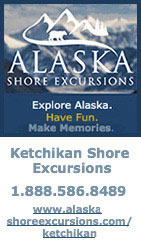|
Fish Factor 2018 Alaska Salmon Season Preliminary Wrap UpBy LAINE WELCH
Friday PM
A preliminary wrap up of the 2018 salmon season by the Alaska Dept. of Fish and Game provides summaries for every fishing region across the state. It shows that sockeye salmon accounted for nearly 60 percent of the total value and 44 percent of the statewide salmon harvest. A catch of 50 million sockeyes added up to nearly $350 million for Alaska fishermen. Chums were the second most valuable catch at $125 million and made up 18 percent of the statewide catch at just over 20 million fish. Pinks accounted for 36 percent of the harvest and 12 percent of the value at nearly $70 million. Coho salmon comprised just three percent of the catch at 3.6 million fish valued at $35.5 million. The Chinook salmon harvest of 234,614 fish was the lowest since limited entry began in 1975, with a value of $16.3 million. Salmon prices paid to fishermen increased across the board this year. Chinook salmon averaged $5.98 a pound, compared to $5.86 last year. Sockeyes averaged $1.33, up 20 cents. Coho prices at $1.34 increased 15 cents a pound. Pinks averaged 45 cents, an increase of 13 cents over last season; chum prices at 78 cents were up 12 cents a pound. The dock prices don’t include post season bonuses and adjustments and the salmon harvests and values will change as fish tickets are finalized. Forecasts for the 2019 salmon season already are trickling in. At Bristol Bay, a run of just over 40 million sockeye salmon is projected next summer which would allow for a catch of 26.6 million fish -- 26.11 million at Bristol Bay and 1.49 million in the South Peninsula fisheries. ADF&G said more salmon forecasts for the 2019 season “will roll out in coming weeks.” Fish watch: Some major Alaska fisheries are winding down for the year, while others are still going strong. In Southeast, a fishery opened on November 8 for seven different kinds of rockfish. About 170 divers are still going down for more than 1.7 million pounds of sea cucumbers, and more than 700,000 pounds of giant geoduck clams. The Dungeness crab fishery is ongoing and Southeast’s golden king crab fishery ends district wide on November 13. Trollers also are out on the water along the Panhandle targeting winter king salmon. Pollock fishing closed to trawlers in both the Bering Sea and Gulf of Alaska on November 1. Ditto for cod except for boats using longline, jig and pot gear. Boats also are still fishing for flounders and many other species of whitefish. Crabbers are close to wrapping up the four million pound red king crab fishery at Bristol Bay; likewise, the take of 2.4 million pounds of Bering Sea Tanner crab is going fast. No landings are reported yet for snow crab; that fishery typically gets underway in mid-January. Fishing for halibut and sablefish (black cod) closed on November 7. For halibut, 95 percent of the nearly 20 million pound catch limit was taken; for sablefish 79 percent of the 26 million pound quota was caught. Homer regained its title as Alaska’s top port for halibut landings, followed closely by Seward and Kodiak. The industry will get its first look at potential halibut catches for next year at the International Pacific Halibut Commission meeting set for Nov. 27-28 in Seattle. Finally, the state Board of Fisheries meets in Dillingham from November 28-December 3 to take up 47 management proposals for Bristol Bay commercial, sports and subsistence fishery issues. Fishing jobs jump: After a steep drop in 2016, seafood harvesting jobs grew 8.3 percent last year, the most in percent terms among all Alaska industries. Harvesting hit a record in 2017 at 8,509 monthly jobs on average and jumped to nearly 25,000 jobs in July. According to the state Department of Labor’s November Economic Trends, salmon fishing jobs grew overall but varied considerably by region. The crab fisheries had the only employment loss. By region, harvesting jobs in the Aleutians jumped by nearly 20 percent, mostly through gains in groundfish catches. Bristol Bay’s fishing jobs also grew overall by 6.2 percent. The Southcentral region continued its trend of harvester job gains, adding 116 jobs for seven percent growth. Southeast Alaska’s fishing jobs were up by 7.7 percent with halibut harvesting growing the most by150 jobs. Kodiak was one of the few areas to lose fishing jobs. While halibut and salmon harvesting jobs increased, losses in groundfish pushed down Kodiak harvesting employment by 81 jobs each month on average. The Yukon Delta also lost fishing jobs in groundfish and salmon for an overall decline of 12.7 percent. The November Trends shows that among all Alaska industries, seafood processing tops the list for injuries. A rate of 8.8 injuries per 100 full time workers is more than double for other Alaska industries, and is one and a half times the national average for food manufacturing. The magazinealso spotlights the six small communities that make up the Aleutians East Borough. Fish moves: Alexa Tonkovich is leaving the helm of the Alaska Seafood Marketing Institute to pursue a master’s degree in international business. Tonkovich has been at ASMI for nine years and has been executive director since 2015. She will leave her position in mid-December. After more than a decade as director of NOAA’s northernmost research lab at Kodiak, Dr. Bob Foy has been named as Science and Research Director for the Alaska Fisheries Science Center. Foy will be based at the Auke Bay lab in Juneau starting this month and will oversee nearly 500 employees at facilities in Seattle, Oregon and Alaska. Foy has gained international recognition for his work on Bering Sea crab stock assessments and impacts of climate change on crabs and other marine organisms.
SitNews ©2018 Stories In The News Ketchikan, Alaska
|
||||



